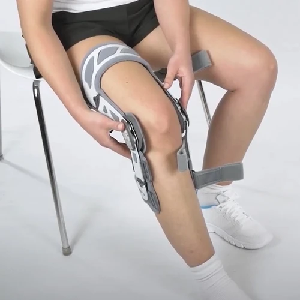Understand the steps you need to follow to properly fit a DonJoy Rigid Knee Brace, available for Ligament Knee Injuries and for Osteoarthritis. Our trained staff can also help with advice on fitting braces - contact us via our Contact page.
The first thing to recommend is to ‘prepare’ the brace by undoing each strap and folding the Velcro back on itself.
This is a good routine for the patient to get into every time they take the brace off. This makes fitting the brace quicker, and they won't need to untangle and unstick all the Velcro straps from each other and their clothes.
Familiarise the patient with the straps and how to adjust the length of them.
You may need to adjust these initially, but once done, the patient won’t need to with every application of the brace.
Another way to think about it, is to start at the lowest strap (front of the shin), and then work your way down from the top strap (back of the thigh).
If the brace has an anti-migration band, think of this as an addition to strap number 4. To apply, continue with the normal order and do both the outer strap 4 and the anti migration band together.
The straps below the knee are the most important - these stop the brace from slipping, and ensure the hinge remains in the correct place. Therefore, the straps below the knee need to be relatively tight.
The straps above the knee, whilst still important, do not need to be as tight.
Now to put the brace on. When seated, with the knee at 45 degrees, place the patient's foot through the brace, and slide up the leg. A key point is to ensure the hinge is sat high enough.
A recommendation here is to line up the middle of the hinge (roughly at the ’N’ in the DonJoy logo) with the top of the kneecap.
Ensure the hinge is sat around the midline of the knee as opposed to too far forward or backwards.
Proceed to applying the straps - feeding the Velcro through the loop opposite, tightening, and fastening back on itself.
You may need to adjust the length of the straps if they are ‘overhanging’ - equally you may need to adjust the positioning of the pads that are on the straps.
For ‘Offloading Braces’ - this is when you need to apply the offload using the Key that arrived with the brace.
Insert the key supplied with the brace and tighten at the two adjustment points, above and below the hinge. Apply the same amount of offload (or as close as you can) at both adjustment points. Note, the patient DOES NOT have to unload the brace when you take the brace off.
The patient needs to be able to feel a small ‘push’ where the hinge is pressing on the knee joint. If there is a gap between the knee and the offloading joint, the brace is not fitting correctly.
Get the patient to stand up and have a move around wearing the brace. If there are any areas that feel loose, adjust the straps accordingly.
This video reviews the process


